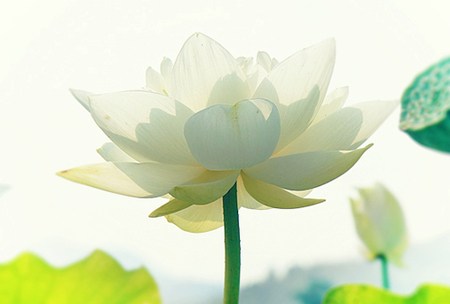The Buddhist lotus
By Fang Sha(chinadaily.com.cn)
|
|
| The lotus [Photo/wutaishan.city.sohu.com] |
Sakyamuni was said to be a Bodhisattva in heaven who is reincarnated in a royal family in the kingdom of Kapilavastu. On her wedding night, the king's wife, Moye, feels a man riding a white elephant coming towards her who becomes smaller and smaller then enters her body. When she is pregnant, her beautiful face looks like a blossoming lotus against her bright green gown which seems like the leaves of the flower. Later Moye gives birth to the baby under a tree and suddenly all the flowers blossom, especially a lotus, as big as a carriage, in a nearby river. As soon as Sakyamuni is born on April 8 of the lunar calendar, he stands on the lotus, which gives rise to the Yufo (bathing on Buddha) Festival. Sakyamuni is often seen sitting on a lotus.
Among the public, the lotus has been popular since ancient India, during the scorching hot summers, when a lotus blooming gave people a refreshing feeling. From its very beginning, Buddhism was tied to folk psychology to attract followers, and the lotus has the role of refreshing people's minds in a world full of annoyance and troubles. Buddhism urges people to reflect on themselves and purify their souls daily to reach a higher spiritual state, where the lotus represents the purification of the soul and is the perfect symbol of Buddhist thought.
The lotus is an important object in Buddhist art and the wall paintings of ancient India and China's Dunhuang Caves in Gansu province, Yungang Grottoes in Shanxi province, and Longmen Grottoes in Henan province, all have the lotus in their art. Buddhist architecture also makes use of the lotus, and most statues of Buddha in temples include it, some with the Buddha sitting on it, some standing on it or holding it.
The lotus also plays a role in traditional medicine, because of its nutrients, where it can be prepared as a dish or made into medicine. Females in the past were said to pick the lotus with morning dewdrops for a facial mask or to eat it to protect their skin because of its moisturizing elements. The tradition of using lotus to make tea is based on the belief that it can relieve summer heat and stimulate the appetite. There are also many stories about the root of the lotus being able to cure diseases.
The lotus in Buddhism is a powerful symbol and is widely worshipped among Buddhists and the Chinese public as well.
Edited by Roger Bradshaw

